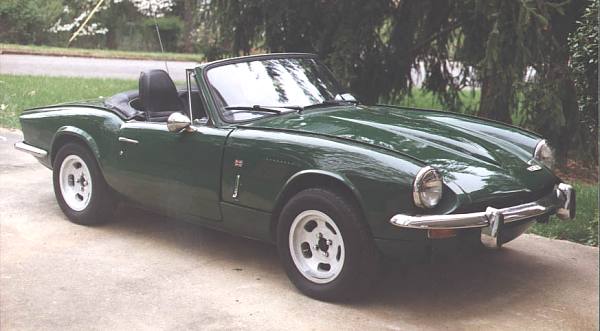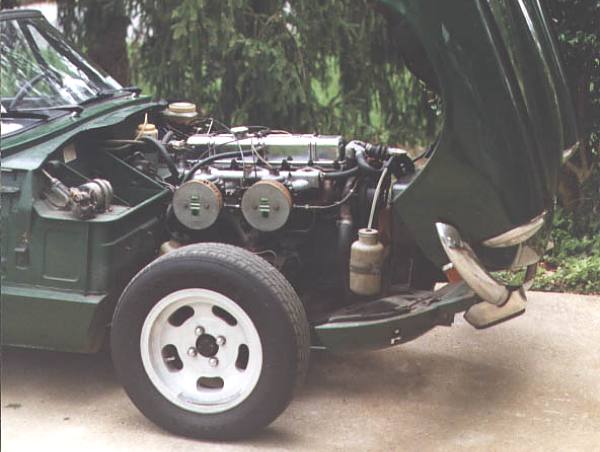�
�
�
�
�
�
� Just your average, immaculate, Spitfire, right? Sorry, this is a wolf in sheep's clothing. � Under that beautiful Spitfire skin beats the heart and soul of a GT6!
�
�
� This is my 1970 GT6+ Roadster. I can't take credit for building this car� - that goes to Rob Stuart. I have owned this car since 1997, when I bought� it from Rob. The car started life as a 1970 GT6+. In about 1985 the GT6� was at the end of its life, and that is when the transformation took place� over the next couple of years.
�
� As you can see from the pictures, it is possible to fit a late model Spitfire� body on an early chassis, and the early style front end doesn't look too� bad. The car also has the GT6+ doors and wing vents. These are a nice feature� because they help to reduce the wind buffeting at speed, and can also be � used to help direct air into the cockpit. The only downside is that I will� have to modify my tonneau cover to fit.�
�
�
�
�
 �
�
Chris Oliver's 1970 GT6+ Roadster
� (as recorded by Dan Masters)� Just your average, immaculate, Spitfire, right? Sorry, this is a wolf in sheep's clothing. � Under that beautiful Spitfire skin beats the heart and soul of a GT6!
�
�
 �
�
�
� This is my 1970 GT6+ Roadster. I can't take credit for building this car� - that goes to Rob Stuart. I have owned this car since 1997, when I bought� it from Rob. The car started life as a 1970 GT6+. In about 1985 the GT6� was at the end of its life, and that is when the transformation took place� over the next couple of years.
�
� As you can see from the pictures, it is possible to fit a late model Spitfire� body on an early chassis, and the early style front end doesn't look too� bad. The car also has the GT6+ doors and wing vents. These are a nice feature� because they help to reduce the wind buffeting at speed, and can also be � used to help direct air into the cockpit. The only downside is that I will� have to modify my tonneau cover to fit.�
�
�
�
� The car is running the rotoflex rear end. To mate this to the car, shock mounts� were welded to the inner fender wells, and the inboard mounts for the radius� arms were opened up and reinforced.
�
� The brakes are stock GT6+, and the body has a recess in the firewall to accept� the dual-line brake master cylinder. This may be a problem if you swap on� a body with a single-line system, as the recess is not there. �
�
�
�
�
 �
�
�
 �
�
�
� The car is running the rotoflex rear end. To mate this to the car, shock mounts� were welded to the inner fender wells, and the inboard mounts for the radius� arms were opened up and reinforced.
�
� The brakes are stock GT6+, and the body has a recess in the firewall to accept� the dual-line brake master cylinder. This may be a problem if you swap on� a body with a single-line system, as the recess is not there. �
�
�
If you are thinking about doing this swap, it is pretty straightforward. The�
only body modification is a small modification to the firewall to clear the�
starter. There would be no modifications to the rear if you go with a non-rotoflex �
rear, but if you do, there are now kits available that locate the shock mounts�
on the frame. This would do away with the need to weld on shock mounts.�
I have also heard that the emergency brake cable guides need to be changed�
from the GT6 tube to the Spit tub. I would also add that the easiest way�
to do this would be to swap the Spit body onto the GT6 frame. Also, if you�
tried to match body types to bonnet types, it would hide the fact that you�
have a bigger engine under the hood.
�
� My car drives very well. The steering is a little heavy at slow speeds, but� I believe that it is caused by the choice of tires and width of them. The� overdrive is great, and the car keeps up with traffic on the interstate while� only turning over at 3000 RPM. The car rides no harder than you would expect� a Spitfire to. Right now, I am running modified KYB gas shocks on the back� (from British Parts Northwest). These are real stiff, and they supply them� for the GT6. I have Koni's on the front, but they will soon be replaced� with KYB's. The car has stock springs and front and rear sway bars.
�
� The pictures I have included are of the GT6 at the end of its life. You can� see the Spit tub behind it , and the bonnets leaning up against the fence.� The other views show it from the front, which I don't think looks too bad,� and the engine. I have also included a shot of the dash. It is GT6, but� instead of using the eye ball vents, I have a TR6 oil pressure gauge and� a voltmeter.�
�
�
�
� My car drives very well. The steering is a little heavy at slow speeds, but� I believe that it is caused by the choice of tires and width of them. The� overdrive is great, and the car keeps up with traffic on the interstate while� only turning over at 3000 RPM. The car rides no harder than you would expect� a Spitfire to. Right now, I am running modified KYB gas shocks on the back� (from British Parts Northwest). These are real stiff, and they supply them� for the GT6. I have Koni's on the front, but they will soon be replaced� with KYB's. The car has stock springs and front and rear sway bars.
�
� The pictures I have included are of the GT6 at the end of its life. You can� see the Spit tub behind it , and the bonnets leaning up against the fence.� The other views show it from the front, which I don't think looks too bad,� and the engine. I have also included a shot of the dash. It is GT6, but� instead of using the eye ball vents, I have a TR6 oil pressure gauge and� a voltmeter.�

